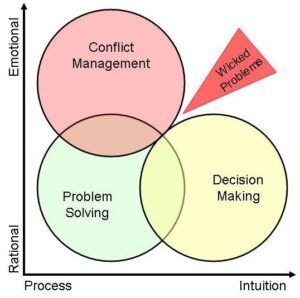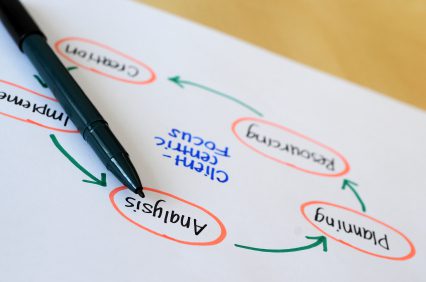Whilst frequently treated as separate topics, conflict management, problem solving and decision making are interrelated and all are focused on achieving the best possible outcome.
In an ideal world there would always be sufficient information and rational maturity to treat everything as a problem and apply the following steps to reach the optimum solution:
- Investigate the problem.
- Define the problem (the way it is defined will influence the solution).
- Identify the root cause.
- Define the solution space.
- Generate options – this can include:
– Group creative processes such as brainstorming;
– Negotiation between parties[1];
– Facilitated processes;
– Reflection and other individual processes. - Decide on the solution that solves the root cause in the simplest way.
- Implement the solution effectively.
- Review the implementation.
Problem solving[2] assumes there is a best answer, the information needed to determine the answer is available and the people involved in the process are acting rationally. These circumstances are relatively rare!
Many of the problems that require solving are rooted in emotions. Every conflict has people acting, or reacting, emotionally at its centre, and conflict management is focused on reducing the effect of emotions to allow the people in conflict to start acting rationally. Any effective solution to a conflict involves defining the problem, defining a solution space (eg, a formal mediation), understanding the options, choosing a solution and then implementing the solution. The only difference is how these steps are implemented or imposed. The standard solution options are:
- Forcing / Directing: the solution is imposed by a manager with adequate power or a tribunal (Judge, Arbitrator or Adjudicator).
- Smoothing / Accommodating: Emphasises agreement, minimises the issues in dispute, allows time for emotions to cool and any residual issues to be resolved through a rational decision making process.
- Compromise / Reconcile: Both sides give something up to resolve the problem – option generation is limited by the level of conflict.
- Problem solving / Collaboration: also referred to as ‘confronting’. A Joint approach to the problem is used to find a mutually acceptable solution (Win-Win) – collaborative decision making
- Withdrawal / Avoidance / Acceptance: allows time for emotions to cool but may no resolve the issue.
Different conflict management[3] processes are appropriate at different times, the primary focus is on reducing or managing the level of conflict, but eventually someone has to decide on the solution to the underlying problems.
Problem solving and decision making are closely aligned. Whilst there is always an underlying problem that requires a solution the weakness of the ‘problem solving’ concept is the assumptions that there is sufficient data to make the ‘right decision’ provided the ‘problem solving’ processes outlined above are applied rationally. Unfortunately many decisions[4] are not that simple!
The types of decision you will be required to make range from ‘simple problems’ through to ‘wicked problems’:
- Wicked problems keep changing and involve stakeholder’s emotions and complexity. You can never really define the problem that needs a decision but still have to decide something! And every decision changes the problem – an iterative, one-step-at-a-time approach is usually best.
- Dilemmas have no ‘right’ answer; you have to use your intuition choose between the ‘lesser of two evils’. Not making a decision is almost always worse than either of the options.
- Conundrums are intricate and difficult question that only have a conjectural answer.
- Puzzles and mysteries lack adequate information to resolve requiring your best decision based on the assessed probabilities ‘at this time’. You never have enough time to get all of the information you need to reduce these decisions to simple ‘problems’ but can use processes to a point.
- Problems just require hard work and the application of ‘problem solving processes’ to get to the best decision.
The challenge of decision making is to understand and balance the following:
- The characteristics of the problem you have to make a decision about;
- The levels of emotion and conflict in the people affected by the decision; and
- The characteristics of the different types of decision you will have to make.
Then having the courage to make the best decision you can[5], in the circumstances as you understand them ‘at this point in time’.
Ultimately, good decision-making is firstly getting most decisions reasonably correct (luck plays a part) and then continually reviewing the consequences of your decisions to adapt, adjust and correct the suboptimal ones as quickly as possible. Generally, any considered decision made in the appropriate time frame is better than no decision or an unnecessarily delayed one.
How do you make your decisions when confronted with the need for a decision?
[1] For more on negotiation see: http://www.mosaicprojects.com.au/WhitePapers/WP1024_Negotiating.pdf
[2] For more on problem solving see: http://www.mosaicprojects.com.au/WhitePapers/WP1013_Problem_Solving.pdf
[3] For more on conflict management see: http://www.mosaicprojects.com.au/WhitePapers/WP1041_Managing_Conflict.pdf
[4] For more on decision making see: http://www.mosaicprojects.com.au/WhitePapers/WP1053_Decision_Making.pdf
[5] Fear destroys the ability of a team to craft a creative decision, see: http://www.mosaicprojects.com.au/Mag_Articles/SA1027_The_Fear_Factor.pdf



